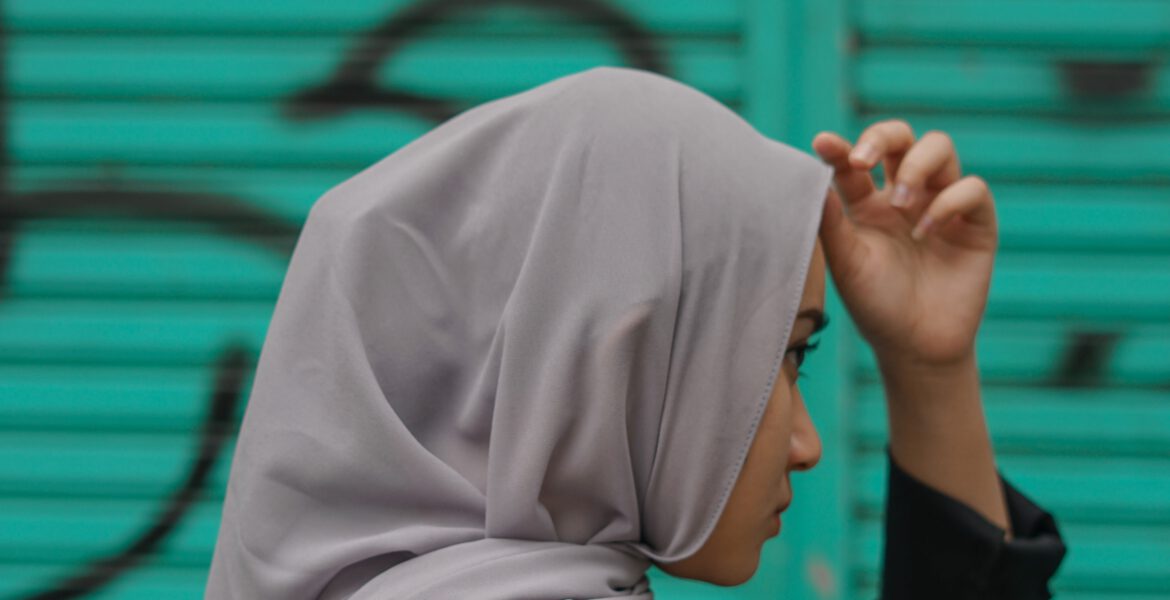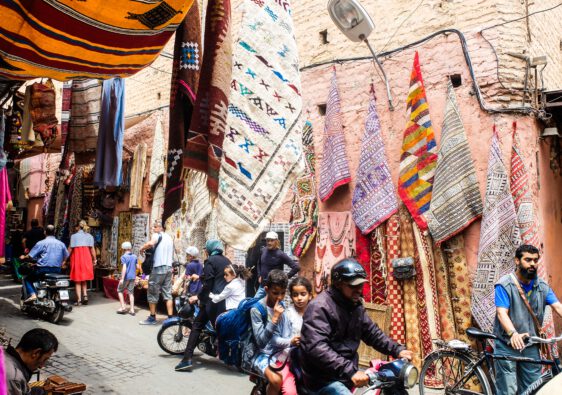Cover up! … No, not you. Not like that!
“What is the event, unimaginable thirty years ago, that is worth mentioning in my new introduction to the reprint of Beyond the Veil, my Ph.D dissertation published in 1975? (…) I realised that the unimaginable event thirty years ago was that the veil has become a fixation of our twenty-first-century, secular, Western man.”[1]
Fatema Mernissi
In 1989, the New York Times was talking about “ARAB GIRLS’ VEILS AT ISSUE IN FRANCE”. This was over 30 years ago. The veil was already perceived as a threat to secularity, a tool of oppression and an extremely divisive and controversial topic.
In reality, the debate is even older. In some colonies, people were already arguing that the headscarf was a symbol of male oppression. Authorities (foreign), actually forced women to take off their veils in countries like Algeria. The colonial political propaganda opposed the “free” Western woman with her hair blowing in the wind to the covered up “other” to legitimise their agenda. Same happened a few decades later, when civilians, including women and children, were bombed in the name of “saving brown women“ in Afghanistan.
Should I tell you about how those who supported unveiling women in the colonies were against women’s right to vote in Europe? Ok, not today!
…but we must know that the instrumentalisation of feminist rhetoric for imperialist, colonial or political ends is not new.
Your mini is someone else’s Hijab!
Do not be fooled the miniskirt is not the opposite of the veil … women are today fighting for the right to safely wear both! Your mini is someone else’s Hijab!
The first women to wear trousers or short skirts in public did so to protest about constraining social rules and laws. When Elizabeth Smith Miller replaced her long and voluminous dress with the “Bloomer costume” it was an act of rebellion against a dress code that complicated women’s lives and limited their mobility. In the 1960’s and the 1970’s the miniskirt became a symbol of emancipation and an expression of the youth’s rejection of bourgeois lifestyles and values [2]. The objective was not to show skin or wear a pair of jeans but to disturb the status quo. Equally, when today women burn their veils, Niqabs and Abayas[3] as an act of protest I honestly do not think that it is about showing hair but about being free to wear whatever (the hell?) they want! When “freedom” is attained, one should not be surprised or disappointed if some women choose to keep their veils while others take it off. Clothing is a visual signifier that can only be interpreted by the context in which it is used and is more complex than fabric or lack thereof!
The obsession with veiling and unveiling is more about political agendas and women taking control over their own bodies than it is about secularism or religion. Every attempt by women to achieve this feminist “holy grail” has been met with resistance and is perceived as a threat to “our” social values and social cohesion. Extremists from both “camps” seem to support the same policy which is to control women’s mobility, visibility and presence in the public sphere. It is a clash of patriarchies and not a clash of civilisations.
Any person interested in the Burkini debate has seen it evolve. It started with the Burkini as unhygienic and then the whole discussion took a political and securitarian twist. In the recent years, covered up women have become potential bomb carriers, terrorists in disguise and their mere visibility has become a danger to secularity and the founding values of the République.
When Manuel Valls, the former French prime minister, talked about «Liberte,Egalite, Fraternite» and decided to add «Laicite a la Francaise» it is all smokes and mirrors. I feel that the “A la Francaise” part is there to ask the non-french to stay away and to remind the French (with a migration background) who might disagree that they are not full-citizens. It takes us back to Sarkozy’s unfamous sentence during the Banlieue crisis “France, love it or leave it” whitout really saying to where.
Valls’ article was an answer to the New York Times who did the unthinkable by giving veiled French Muslim women a space to talk about their experiences. The article exposed who these women identified as being the real oppressors and by doing so, the NYT probably hit a raw nerve. In his response, entitled “En France les Femmes sont Libres” “In France Women are Free”, the French Prime Minister is dimissing and invalidating all those voices by imposing his interpretation of religion, fashion and laicite (a la Francaise?).
So I did my homework, typed keywords on a search engine and read the law’s six titles and 44 articles. The first article of the 1905 French law “describes the purpose of the act, which is to ensure “freedom of conscience” and to guarantee “the free exercise of religion under the provisions enacted hereafter in the interest of public order”. I hope that we still agree that public order can only be disturbed by acts, not outfits and that it is unhealthy to react to what I have just said by straying into debates about nudism in the public sphere. (I am on to you Caroline Fourest).
The separation of Church and State was meant to be about freedom (of belief and disbelief) and equality before the law. The 1905 French Laicity law specifies criminal penalties for any person:
Yes Hind but the Taliban and the Mollahs…
I am, by no means, trying to undermine the struggle of the women who see the headscarf as a tool of oppression and who have to undergo forced veiling. This is the main reason why when I talk about Burkinis in the French Riviera I refuse to get lost in discussions about Burkas, the Taliban, the Mullahs or even the hostility that veiled and/or unveiled women might face in some countries. These are different topics.
The bottom line is that a woman should be allowed to wear whatever she wants and if it is a veil so be it! I am tempted to say that nobody has appointed “you” as liberator of the veiled, the weak and the oppressed, especially if “you” are planning to force this liberation on them!
Let’s assum that the Burkini and the Veil are nothing but humiliation and oppression. How is banning them an emancipation or empowerment tool? What do governments offer in terms of material, legal and psychological support to oppressed Muslim women? I mean besides asking them to undress or using them in TV shows to support xenophobic discourses and anti-immigration policies? I am not talking about brown women in faraway countries but European Muslim women. How are they, as citizens of great democracies, saved from their oppressors? How is excluding veiled women from the public sphere helping them in any way?
I also want to stress that there is no such a thing called “Islamic dress”. There is no uniform in Islam, and veils come in different colors, styles and lengths. Modesty is the only rule but this is not proper to Islam or to religion for that matter. In many multi-faith countries you would not be able to guess people’s religion and religiosity from their outfit.
To finish, I would like to talk about how really free are we, as women, to wear bikinis.
We live in a society where “beach body” is a thing and too many women are shamed for their “secular” outfit choices.
When you are told that you should not wear those shorts because they make you look like a wh*re or that they are not age/body shape appropriate you are not really free. Too often when a victim of sexual assault or harassment comes forward to share their story, they are asked what they were wearing, when and where they were when it happened … It usually comes down to the same reasoning: “I do not like what you are wearing! Go change, stay home or accept what happens to you!”
When your morality, citizenship and/or agency are measured in inches, there is a problem. When a person, an organization or a government think they are allowed to cover you up or strip you down there is an even bigger problem.
Women of different faiths, atheists or even men can wear a Burkini if they wish! I do not think that the Burkini discriminates. It is pretty secular (wink wink!).
If the Burkini, the veil, a cosmonaut suit or anything else helps any woman overcome whatever it is that stops her from going to the beach or living her life as she wishes LET HER GO FOR IT! Anything that makes anyone’s life easier should be encouraged.
It does not need to be one or the other. All styles can coexists. The day we win the battle against populism and commit to an inclusive society, a lot of the hate will simply vanish. I will have to find something else to rant about, but I am sure this won’t be an issue.
Photo by Nada Hanifah on Unsplash
References
- Mernissi, Fatema (2011–10–10). Beyond the Veil: Male-Female Dynamics in Muslim Society (Saqi Essentials) (p. 7). Saqi. Kindle Edition.
- Paulicelli, Eugenia; Clark, Hazel (2009). The Fabric of Cultures: Fashion, Identity, and Globalization. Routledge.
- Black long dress women wear mainly in the Gulf countries






